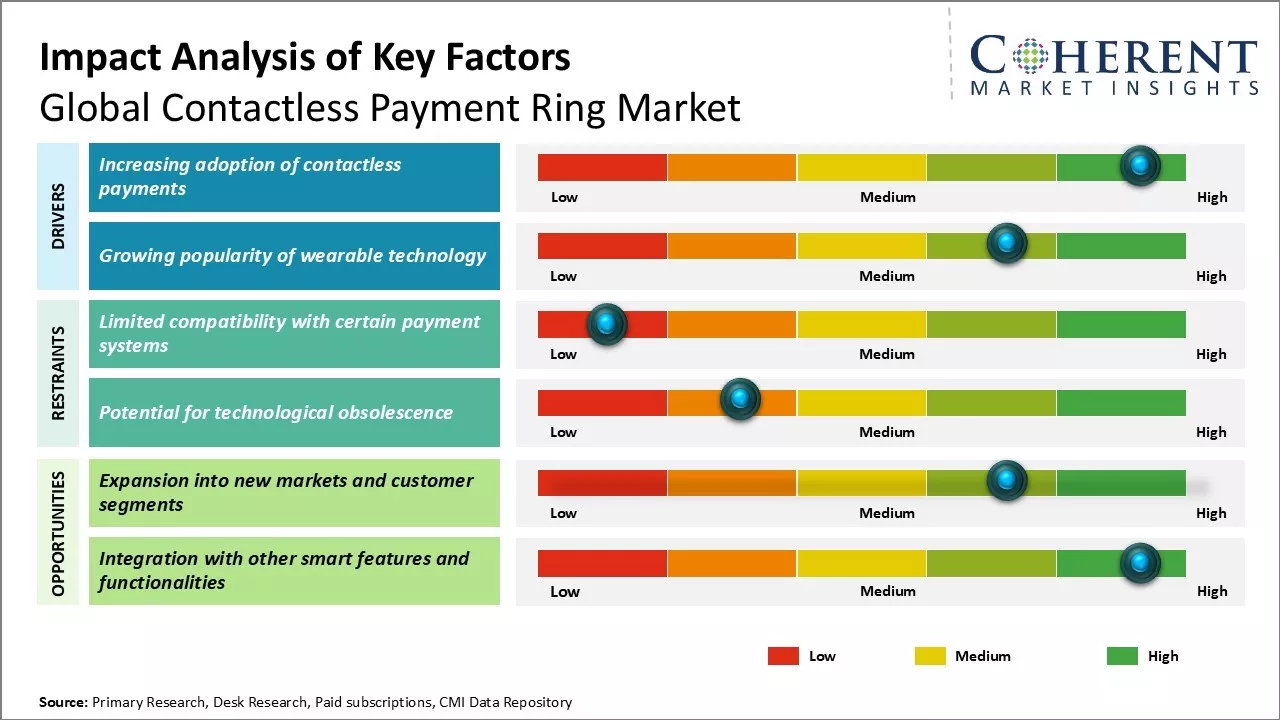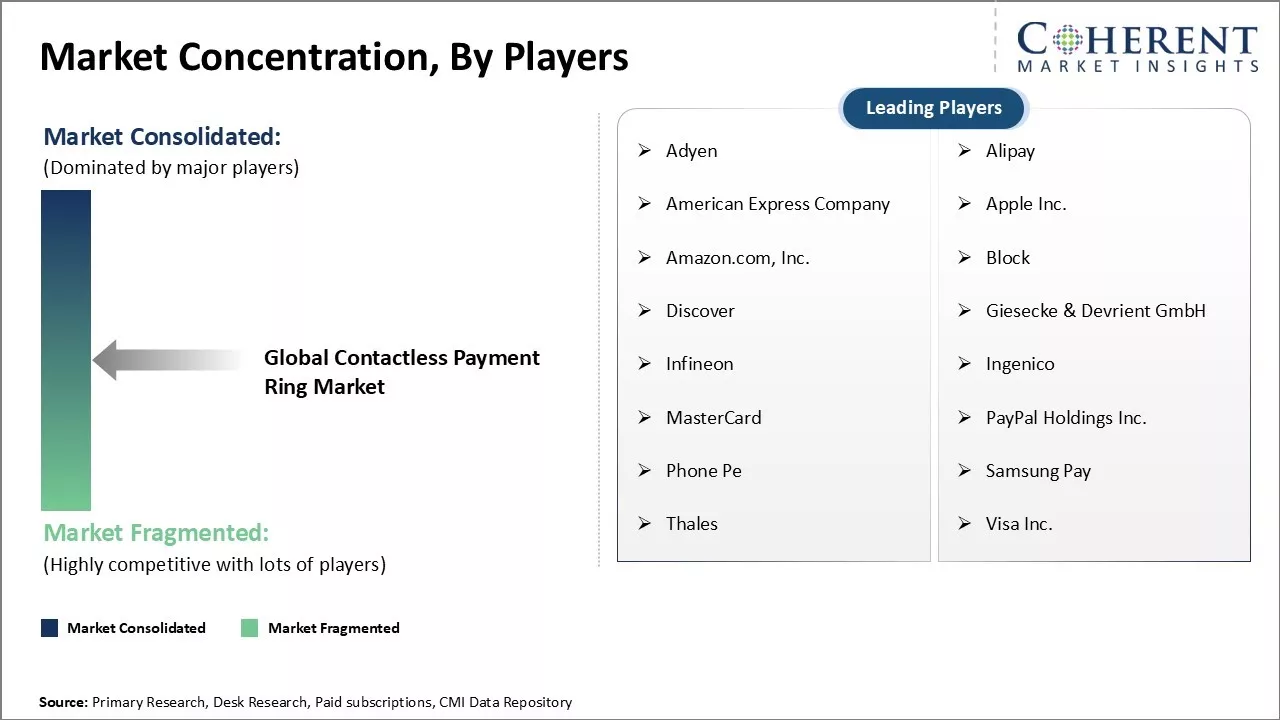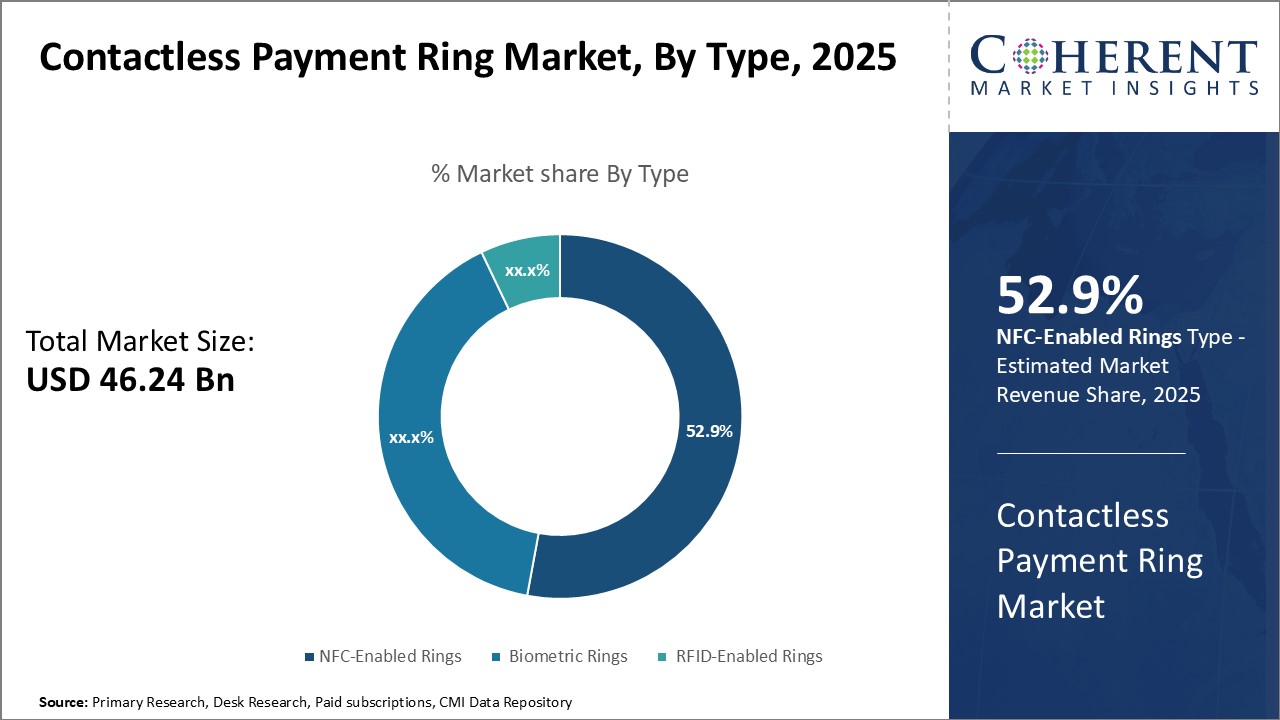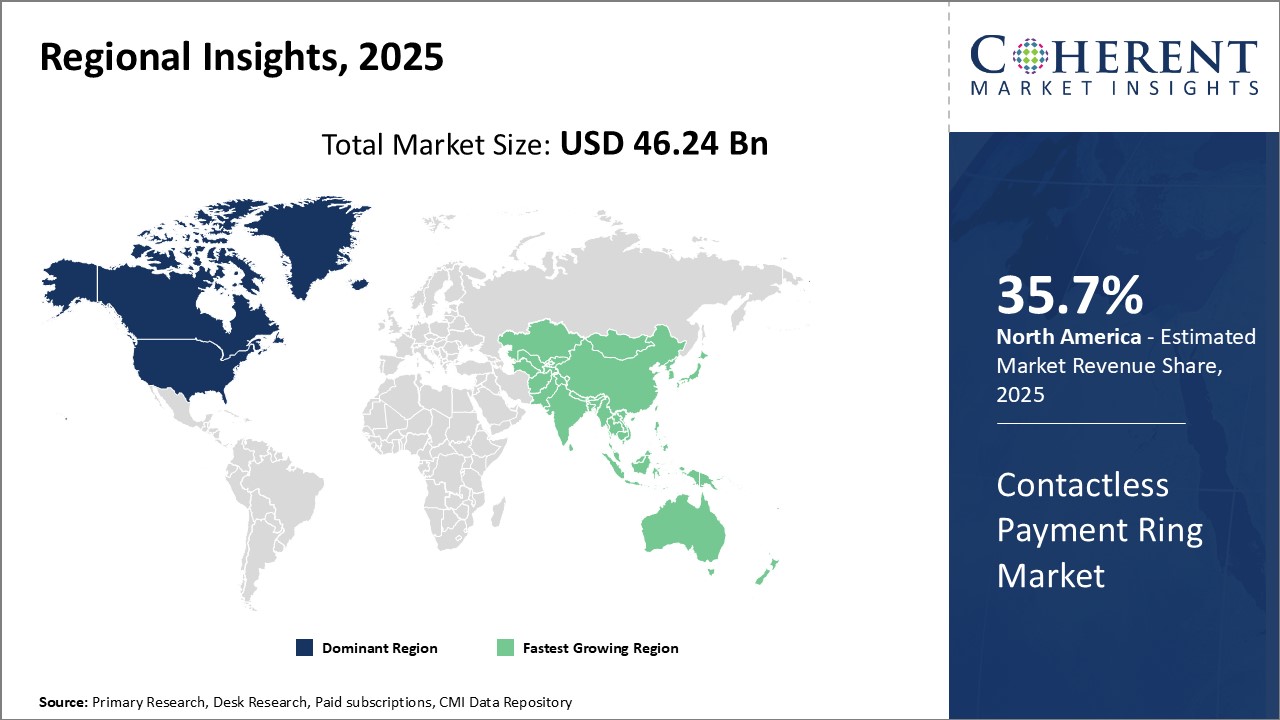Contactless Payment Ring Market Size and Trends
The global contactless payment ring market is estimated to be valued at USD 46.24 Bn in 2025 and is expected to reach USD 159.15 Bn by 2032, exhibiting a compound annual growth rate (CAGR) of 19.3% from 2025 to 2032.

Discover market dynamics shaping the industry: Download Free Sample
Rising adoption of tokenization and contactless payments globally are driving the demand for contactless payment rings. Growing preference for hassle-free and convenient payment modes among consumers is further propelling the market growth. In addition, increasing partnerships between ring manufacturers and payment solution providers to integrate payment functionality in jewelry is expected to support the market growth. However, data security and privacy concerns associated with contactless payment rings may hamper the demand to some extent. Nonetheless, ongoing technological advancements in contactless payment technologies are expected to create lucrative opportunities for contactless payment ring manufacturers over the next few years.
Increasing adoption of contactless payments
The global payments landscape has witnessed a massive shift towards contactless and digital methods over the past few years. The COVID-19 pandemic has further accelerated this trend as more consumers now prefer touch-free transactions for safety and hygiene reasons. Contactless cards were already gaining popularity prior to 2020 due to their ease of use and speed compared to traditional chip-and-pin cards. However, health concerns have transformed Contactless Payment Ring into the preferred way to pay for many. Merchants are also incentivizing contactless payments by prominently displaying related signages and installing additional contactless acceptance terminals.
Consumers find Contactless Payment Ring both swift and frictionless. All it requires is a simple wave or tap of the card or device near the payment terminal, eliminating the need to insert or swipe the card as well as enter a PIN. This provides a much faster checkout experience, especially for low-value transactions. Moreover, the increased transaction limits of major networks have further augmented their usage.
Governments and transit authorities have also played a role by supporting fare payments via open payment systems and contactless bank cards. This has put contactless infrastructure in place across public transportation networks. As more and more consumers get familiar with contactless through these everyday uses, it drives further adoption in other verticals too. All these factors have established Contactless Payment Ring as one of the most prevalent new payment behaviors across developed nations. With rising consumer preference and awareness as well as merchant acceptance, contactless payments are expected to account for a larger share of total transactions over the coming years.
Market Concentration and Competitive Landscape

Get actionable strategies to beat competition: Download Free Sample
Growing popularity of wearable technology
Wearable devices, such as smartwatches and fitness bands, have witnessed phenomenal growth in recent times owing to the various functionalities and convenience they offer. As these wearables become more sophisticated with additional features, they are emerging as alternative payment methods. Technology giants are prioritizing payment capabilities for their wearables realizing the opportunity it presents. Contactless payment rings can particularly leverage the increasing volumes of smartwatch shipments.
Users have shown willingness to link their payment credentials to wearable devices as it allows them to leave their physical wallets behind. Contactless payment rings become an attractive option for making payments on-the-go using just a wrist flick. Its discreet form factor avoids the hassle of getting phones or cards out of bags or wallets during payment. This further enhances the ease and immediacy of usage. The fitness tracking potentials of such rings would also open up new avenues like pay-as-you-exercise programs thereby strengthening their value proposition.
Advancements in near field communication (NFC) technology have allowed contactless payments to be integrated into a wide range of connected devices beyond smartphones. Major technology companies like Apple, Samsung, and Google among others is heavily promoting wearables as the next frontier of payments innovation and competing to expand their respective payment ecosystems. Rising wearable shipments fuel consumer familiarity with 'pay with your watch' concept which creates opportunities for specialized payment rings as well. Their proliferation represents growing consumer interest towards streamlining all daily tasks into body-worn devices for added convenience. This provides a conducive environment for contactless payment rings market to harness.
For instance, in June 2024, MuchBetter, a leading provider of wearable payment technology, introduced a contactless payment ring in Italy that users can obtain for free by loading it with €100 through the accompanying app. This stylish and innovative ring offers a convenient payment solution, enabling users to make transactions globally wherever Mastercard is accepted, while also challenging traditional pricing structures in the wearable technology sector.
Key Takeaways from Analyst:
Wearable payment devices are gaining widespread acceptance among consumers, especially millennials and Gen Z who are adopting new technologies readily. Rings provide a stylish form factor for contactless payments and their small size allows easy discreet payments. North America is expected to dominate the market owing to the proliferation of payments apps like Alipay and WeChat Pay that have made mobile payments a way of life. Increasing adoption of mobile wallets and digital transactions even in lower tier cities will drive gains in North America.
Security remains a key concern for the higher adoption of payment rings. However, innovations in encryption and authentication by ring manufacturers are helping address consumer security concerns and build trust in this new payment method. High production costs currently pose a challenge but economies of scale and new fabrication methods may help lower costs. Interoperability between payment networks worldwide could accelerate international travel payments using rings.
Asia Pacific is anticipated to emerge as the fastest growing regional market as affinity for wearable technology and interest in novel payment options increases fragmentation in card networks. Meanwhile, Europe and the Middle East will witness steady growth led by Nordic countries where digital transactions are commonplace even for small value payments.
Market Challenge - Limited compatibility with certain payment systems
As contactless payment rings continue to develop and grow in popularity, one of the major challenges this market faces is limited compatibility with certain existing payment systems. While contactless payment rings can be used at point-of-sale readers that support tap-and-pay technologies like NFC, they may not be compatible with payment apps run by specific banks, fintech companies, or mobile wallets. This lack of universal compatibility could negatively impact consumer adoption rates, as people want a seamless experience using the same device or card for all payments. Market players will need to focus on partnerships and integration with major payment networks and their members to ensure their rings can facilitate mobile wallet payments, bank transfers, transit fare payments, and others. Without broad compatibility that satisfies consumer needs, contactless rings risk being left out of mainstream use if seen as limited in scope.
Market Opportunity - Expansion into new markets and customer segments
The expanding global contactless payment ring market presents significant opportunities for players to expand into new regional markets and target additional customer segments. While current adoption is the highest in North America and parts of Europe, growth potential exists in developing key Asian and South American countries that are quickly embracing digital and mobile payments. Contactless rings also allow expansion beyond traditional consumers to new segments like youth, athletes involved in contact sports, healthcare professionals needing hygienic payment options, and customers concerned with data security when paying with phones. By cultivating partnerships, customs, and marketing relevant to needs in emerging nations and niche user groups, contactless ring providers can achieve broader global sales and cement their products as a mainstream accessory choice beyond early adopter tech enthusiasts.

Discover high revenue pocket segments and roadmap to it: Download Free Sample
Insights by Type: The Dominance of NFC-enabled Rings Driven by Convenience
In terms of type, NFC-enabled rings contributes 52.9% share of the market in 2025 owing to their unmatched convenience. NFC technology allows users to pay for transactions with just a tap of their ring on payment terminals, eliminating the need to pull out physical cards or mobile devices. This contactless payment experience is super-fast and seamless which benefit both customers and merchants. NFC rings are also much more discreet and private than other payment methods as users can complete transactions without flashing their payment instrument. The hassle-free payment flows coupled with strong privacy appeals have made NFC rings immensely popular.
Insights by Payment Method: Dominance of Credit/Debit Card Segment Driven by Plastic
In terms of payment method, credit/debit card contributes 66.2% share of the market in 2025 owing to their wide acceptance and established infrastructure. Credit and debit cards have been used for payments globally for decades now. Merchants already have point-of-sale card readers in place and consumers are accustomed to the credit card user experience. The familiarity and familiarity of plastic has helped cards maintain their lead over other payment methods even as digital payments rise. Additionally, leading card networks have been investing heavily promote credit card transactions which have boosted cards' first-mover advantage in the Contactless Payment Ring Market.
Insights by End User: The Dominance of Individual Users Driven by a Strong Sense of Empowerment
In terms of end user, individual users contribute 71.8% share of the market in 2025 due to a strong sense of empowerment experienced by individual users. Contactless Payment Ring free up individuals from the need to carry physical wallets or obtain merchant permission for mobile payments. This portability and autonomy enable users to manage their finances and spend at will, fueling the perception of enhanced independence. Additionally, entertainment and lifestyle-driven millennials and Gen Z strongly relish technologies that blend seamlessly with fashion and contribute to self-expression. NFC rings satisfy this desire for personal style along with retail therapy, compelling many individuals to adopt them.
Regional Insights

Need a Different Region or Segment? Download Free Sample
North America has established itself as the dominant region in the global contactless payment ring market. The region is expected to hold 35.7% of the market share in 2025. The large and developed nature of key markets like the U.S. and Canada has led to the widespread adoption of contactless payments over the past decade. Consumers in North America have readily embraced contactless cards and mobile payments at retail stores, contributing to high volumes. Additionally, prominent North American technology companies have driven innovation in the space through investing in new product development and partnerships with financial institutions. This has ensured that North America maintains the latest technologies compared to other regions.
The pricing structure of contactless payment rings in North America also makes it attractive for manufacturers and distributors. Higher average selling prices allow companies to recover costs quicker and invest further in marketing initiatives to boost awareness and trials among consumers. Strong intellectual property laws further protect new product designs. Overall, the large and affluent consumer base coupled with supportive policies have cemented North America's pole position in the global contactless payment ring market.
Among emerging markets, Asia Pacific displays promising potential for future growth. Countries like China, India, and several Southeast Asian nations are experiencing increasing digitalization of payments. This stems from rising smartphone penetration driving the popularity of mobile wallets, and a push by governments to move transactions from cash to cashless modes. For example, India's demonetization plan in 2016 accelerated growth of digital and contactless technologies.
The vast untapped consumer base across Asia Pacific presents a major opportunity. Favorable demographics with burgeoning middle-income populations and urbanization trends will propel spending and experimentation with new payment innovations like contactless rings. Asia Pacific also hosts competent manufacturing capabilities and competitive supply chains for companies operating in this space. As consumer adoption trends upward supported by enabling banking infrastructure investments, Asia Pacific is poised to become the fastest growing regional market for contactless payment rings globally.
Market Report Scope
Contactless Payment Ring Market Report Coverage
| Report Coverage | Details | ||
|---|---|---|---|
| Base Year: | 2024 | Market Size in 2025: | USD 46.24 Bn |
| Historical Data for: | 2020 To 2024 | Forecast Period: | 2025 To 2032 |
| Forecast Period 2025 to 2032 CAGR: | 19.3% | 2032 Value Projection: | USD 159.15 Bn |
| Geographies covered: |
|
||
| Segments covered: |
|
||
| Companies covered: |
Adyen, Alipay, American Express Company, Apple Inc., Amazon.com, Inc., Block, Discover, Giesecke & Devrient GmbH, Infineon, Ingenico, MasterCard, PayPal Holdings Inc., Phone Pe, Samsung Pay, Thales, and Visa Inc. |
||
| Growth Drivers: |
|
||
| Restraints & Challenges: |
|
||
Uncover macros and micros vetted on 75+ parameters: Get instant access to report
Contactless Payment Ring Industry News
- In July 2024, VezoPay, a leading innovator in payment technology, introduced Africa's first smart ring, marking a significant advancement in contactless payment solutions across the continent. Designed for both convenience and security, the VezoPay smart ring showcases a range of cutting-edge features that epitomize the future of digital transactions.
- In June 2024, MuchBetter, a pioneering provider of wearable payment technology, launched a contactless payments ring in Italy that is available for free, provided users load it with €100 through the associated app. This innovative ring offers a stylish and convenient payment solution, allowing users to make transactions globally wherever Mastercard is accepted, while challenging traditional pricing models in the wearable tech market.
- In March 2024, IndusInd Bank, a leading private sector bank in India with over 39 million customers, announced the launch of its contactless payments wearables, 'Indus PayWear.' This innovative offering is India's first all-in-one tokenizable wearable device that supports both debit and credit cards exclusively on Mastercard. The bank plans to extend this service to other card networks shortly, providing customers with greater flexibility and convenience in making payments.
- In December 2021, Visa Inc., the global leader in digital payments, unveiled a comprehensive roadmap aimed at enhancing payment security in India. This initiative is designed to protect India's evolving digital payments ecosystem from emerging threats and cyberattacks, ensuring a secure environment for consumers and businesses alike.
- In September 2021, PayPal, a leading digital payments platform with over 400 million users worldwide, launched its new all-in-one app designed to enhance financial services for customers. This innovative PayPal app features a unified dashboard for account management, a wallet tab for overseeing payment methods and various financial services aimed at improving the overall customer experience.
*Definition: The global contactless payment ring market involves the sales of contactless payment rings that contain integrated chips that enable contactless payment through radio-frequency identification (RFID) or near-field communication (NFC) technology. These rings can be used to make payments at merchant locations that accept contactless payments, by simply waving the ring over a contactless payment terminal without the need to insert or swipe a payment card. The ring is connected to the user's payment account and allows secure, tap-and-go payments.
Market Segmentation
- By Type Insights (Revenue, USD Bn, 2020 - 2032)
-
- NFC-Enabled Rings
- Biometric Rings
- RFID-Enabled Rings
- By Payment Method Insights (Revenue, USD Bn, 2020 - 2032)
-
- Credit/Debit Card
- Mobile Wallet
- Others (Prepaid, Loyalty, etc.)
- By End User Insights (Revenue, USD Bn, 2020 - 2032)
-
- Individual Users
- Corporate/Enterprise Users
- Regional Insights (Revenue, USD Bn 2020 - 2032)
- North America
- U.S.
- Canada
- Latin America
- Brazil
- Argentina
- Mexico
- Rest of Latin America
- Europe
- Germany
- U.K.
- Spain
- France
- Italy
- Russia
- Rest of Europe
- Asia Pacific
- China
- India
- Japan
- Australia
- South Korea
- ASEAN
- Rest of Asia Pacific
- Middle East
- GCC Countries
- Israel
- Rest of Middle East
- Africa
- South Africa
- North Africa
- Central Africa
- North America
- Key Players Insights
- Adyen
- Alipay
- American Express Company
- Apple Inc.
- com, Inc.
- Block
- Discover
- Giesecke & Devrient GmbH
- Infineon
- Ingenico
- MasterCard
- PayPal Holdings Inc.
- Phone Pe
- Samsung Pay
- Thales
- Visa Inc.
Share
Share
About Author
Yash Doshi is a Senior Management Consultant. He has 12+ years of experience in conducting research and handling consulting projects across verticals in APAC, EMEA, and the Americas.
He brings strong acumen in helping chemical companies navigate complex challenges and identify growth opportunities. He has deep expertise across the chemicals value chain, including commodity, specialty and fine chemicals, plastics and polymers, and petrochemicals. Yash is a sought-after speaker at industry conferences and contributes to various publications on topics related commodity, specialty and fine chemicals, plastics and polymers, and petrochemicals.
Missing comfort of reading report in your local language? Find your preferred language :
Transform your Strategy with Exclusive Trending Reports :
Frequently Asked Questions
EXISTING CLIENTELE
Joining thousands of companies around the world committed to making the Excellent Business Solutions.
View All Our Clients
